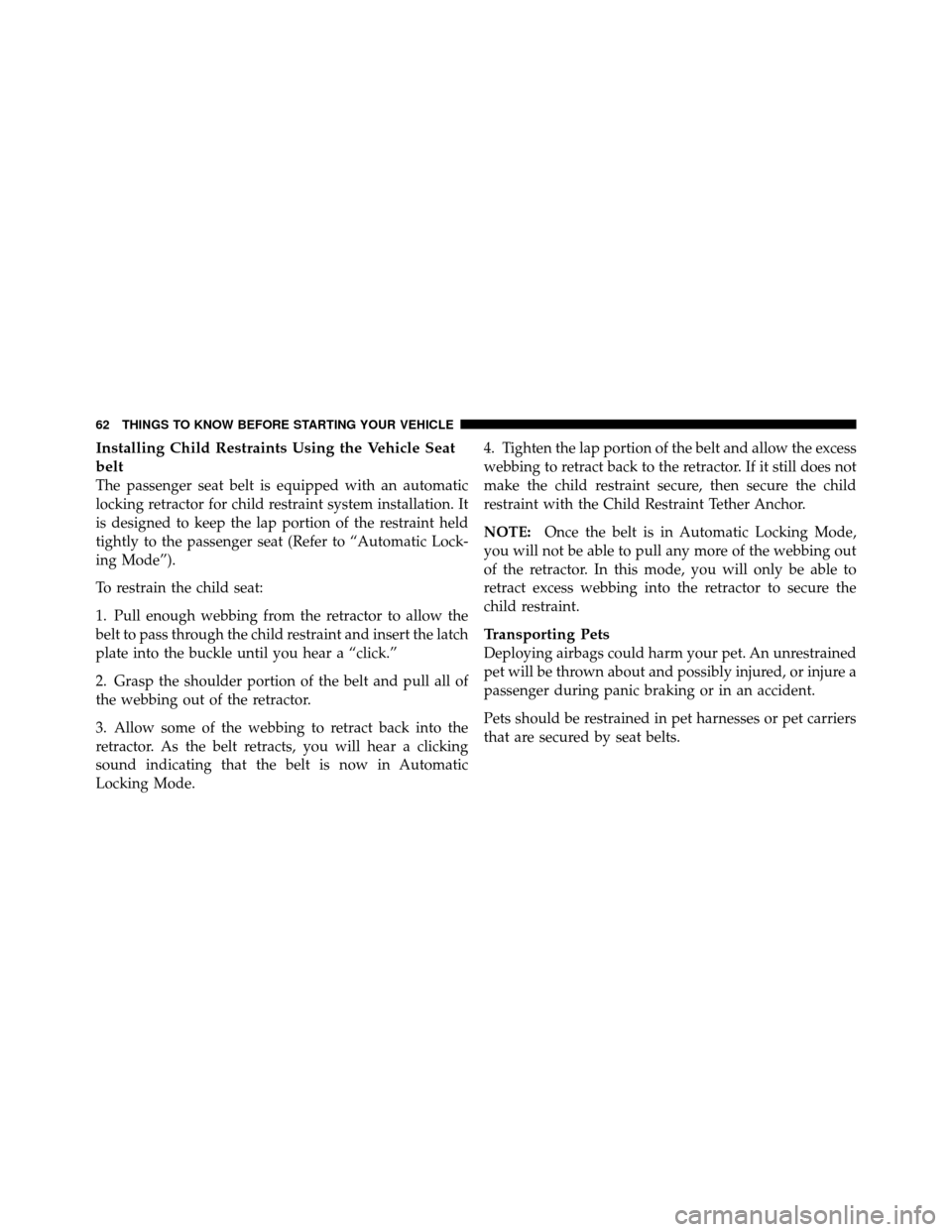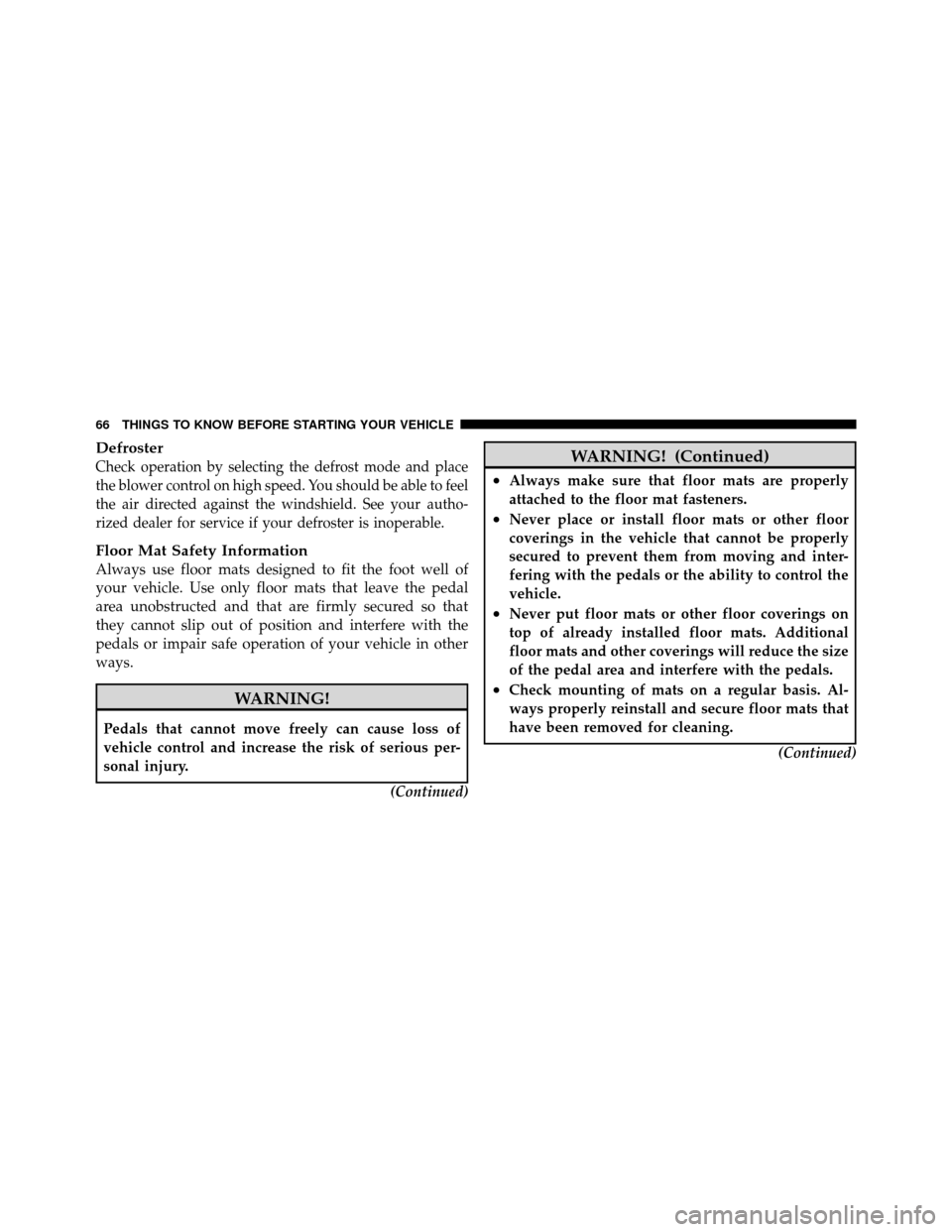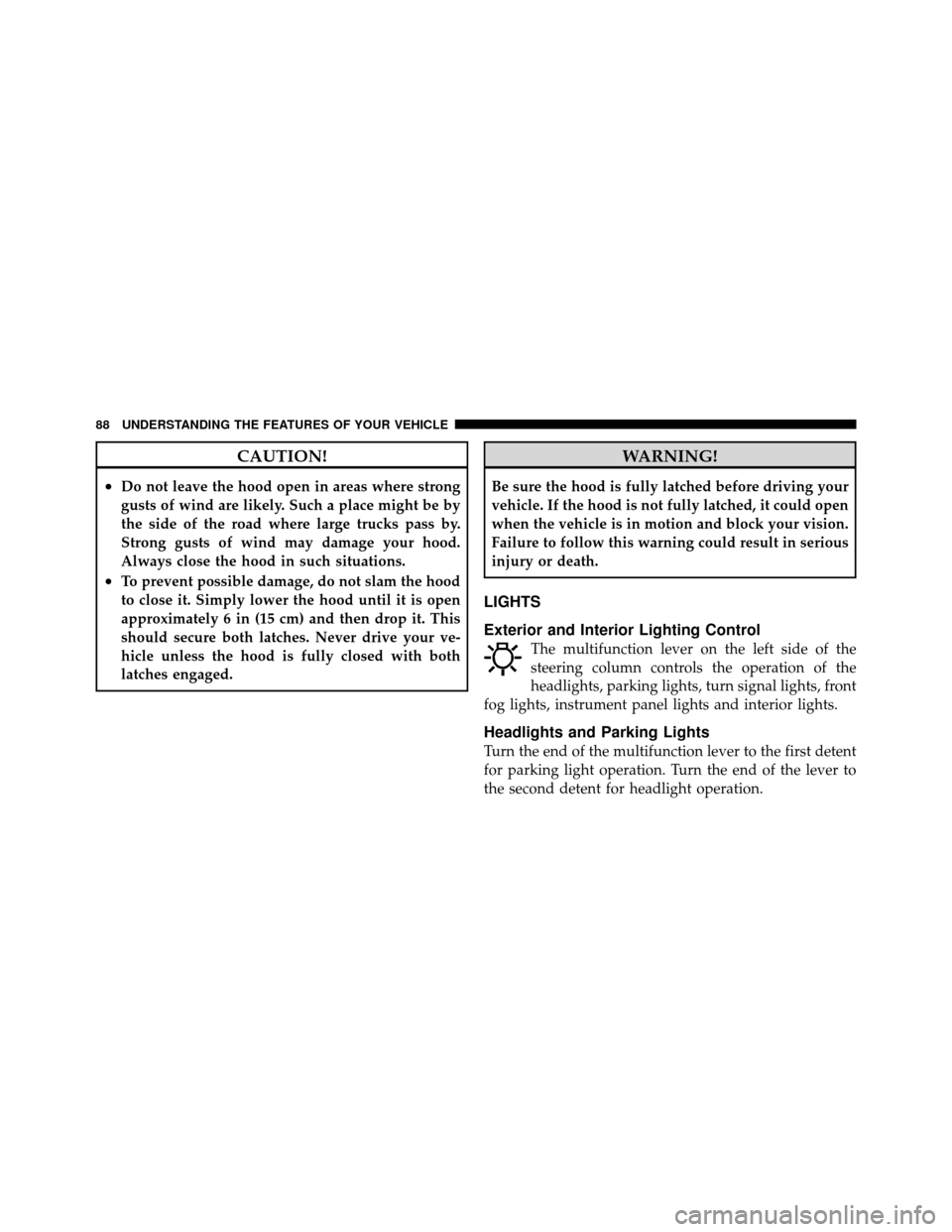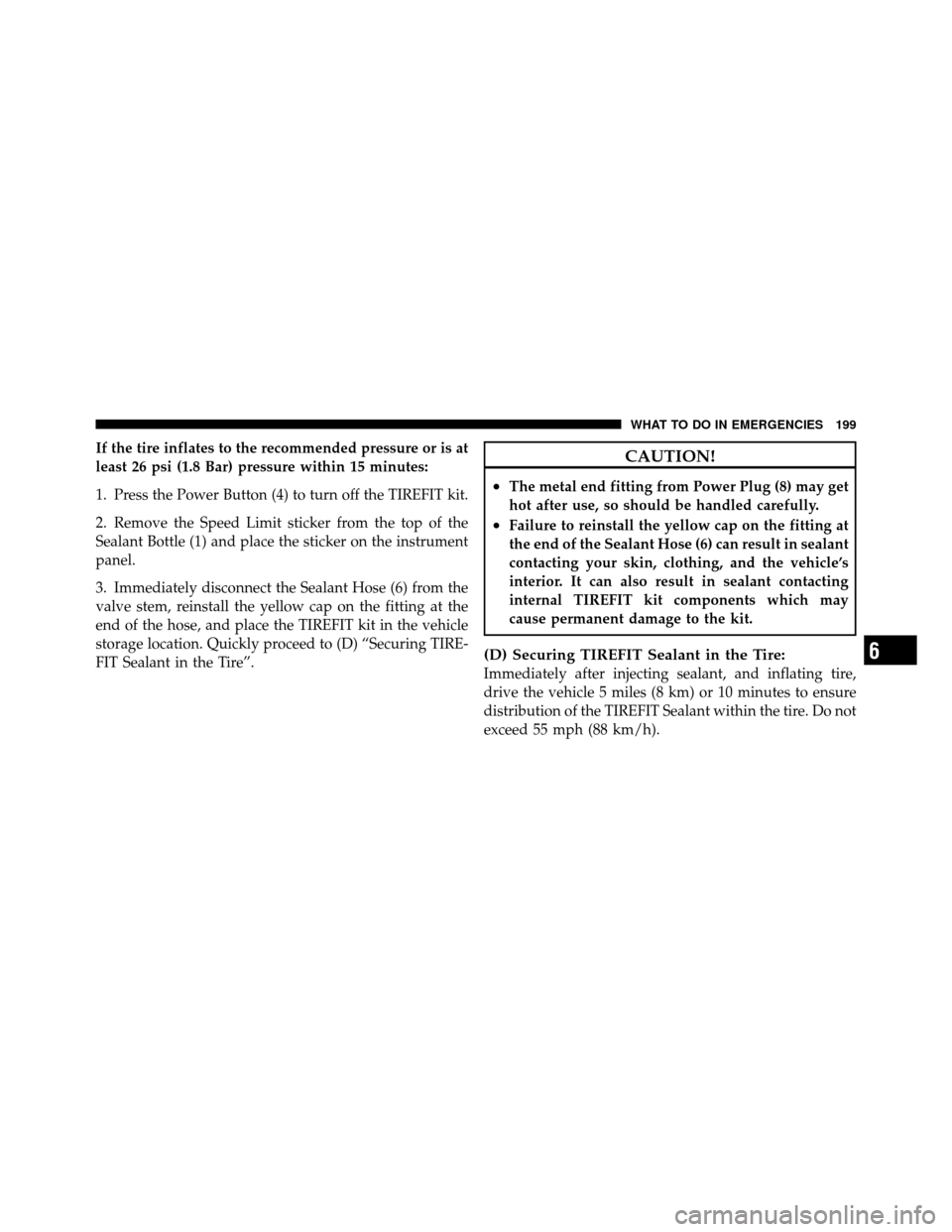Page 65 of 315
5. Attach the tether hook to the anchor loop.
6. Move the seat to its farthest rearward position. Apply
body pressure to the seat to be sure the seat adjusters
have latched.7. Return the seatback to an upright position.
8. Install the child restraint according to the manufactur-
er’s directions.
9. Remove slack from the tether strap according to the
child restraint manufacturer’s directions.
WARNING!
An incorrectly anchored tether strap could lead to
increased head motion and possible injury to the
child. Use only the anchor position directly behind
the child seat to secure a child restraint top tether
strap.
Tether Hook
2
THINGS TO KNOW BEFORE STARTING YOUR VEHICLE 61
Page 66 of 315

Installing Child Restraints Using the Vehicle Seat
belt
The passenger seat belt is equipped with an automatic
locking retractor for child restraint system installation. It
is designed to keep the lap portion of the restraint held
tightly to the passenger seat (Refer to “Automatic Lock-
ing Mode”).
To restrain the child seat:
1. Pull enough webbing from the retractor to allow the
belt to pass through the child restraint and insert the latch
plate into the buckle until you hear a “click.”
2. Grasp the shoulder portion of the belt and pull all of
the webbing out of the retractor.
3. Allow some of the webbing to retract back into the
retractor. As the belt retracts, you will hear a clicking
sound indicating that the belt is now in Automatic
Locking Mode.4. Tighten the lap portion of the belt and allow the excess
webbing to retract back to the retractor. If it still does not
make the child restraint secure, then secure the child
restraint with the Child Restraint Tether Anchor.
NOTE:
Once the belt is in Automatic Locking Mode,
you will not be able to pull any more of the webbing out
of the retractor. In this mode, you will only be able to
retract excess webbing into the retractor to secure the
child restraint.
Transporting Pets
Deploying airbags could harm your pet. An unrestrained
pet will be thrown about and possibly injured, or injure a
passenger during panic braking or in an accident.
Pets should be restrained in pet harnesses or pet carriers
that are secured by seat belts.
62 THINGS TO KNOW BEFORE STARTING YOUR VEHICLE
Page 70 of 315

Defroster
Check operation by selecting the defrost mode and place
the blower control on high speed. You should be able to feel
the air directed against the windshield. See your autho-
rized dealer for service if your defroster is inoperable.
Floor Mat Safety Information
Always use floor mats designed to fit the foot well of
your vehicle. Use only floor mats that leave the pedal
area unobstructed and that are firmly secured so that
they cannot slip out of position and interfere with the
pedals or impair safe operation of your vehicle in other
ways.
WARNING!
Pedals that cannot move freely can cause loss of
vehicle control and increase the risk of serious per-
sonal injury.(Continued)
WARNING! (Continued)
•Always make sure that floor mats are properly
attached to the floor mat fasteners.
•Never place or install floor mats or other floor
coverings in the vehicle that cannot be properly
secured to prevent them from moving and inter-
fering with the pedals or the ability to control the
vehicle.
•Never put floor mats or other floor coverings on
top of already installed floor mats. Additional
floor mats and other coverings will reduce the size
of the pedal area and interfere with the pedals.
•Check mounting of mats on a regular basis. Al-
ways properly reinstall and secure floor mats that
have been removed for cleaning.(Continued)
66 THINGS TO KNOW BEFORE STARTING YOUR VEHICLE
Page 86 of 315
8. Fold the boot cover again.
9. Place the boot cover into the bag and store it in the
trunk or a secure dry area.
10. Close the trunk.MIRRORS
Inside Day/Night Mirror
Adjust the mirror to center on the view through the rear
window. A pivot system allows for horizontal and verti-
cal mirror adjustment.
Headlight glare can be reduced by moving the small
control under the mirror to the night position (toward the
rear of the vehicle). The mirror should be adjusted while
set in the day position (toward the windshield).
Folding Boot Cover
82 UNDERSTANDING THE FEATURES OF YOUR VEHICLE
Page 92 of 315

CAUTION!
•Do not leave the hood open in areas where strong
gusts of wind are likely. Such a place might be by
the side of the road where large trucks pass by.
Strong gusts of wind may damage your hood.
Always close the hood in such situations.
•To prevent possible damage, do not slam the hood
to close it. Simply lower the hood until it is open
approximately 6 in (15 cm) and then drop it. This
should secure both latches. Never drive your ve-
hicle unless the hood is fully closed with both
latches engaged.
WARNING!
Be sure the hood is fully latched before driving your
vehicle. If the hood is not fully latched, it could open
when the vehicle is in motion and block your vision.
Failure to follow this warning could result in serious
injury or death.
LIGHTS
Exterior and Interior Lighting Control
The multifunction lever on the left side of the
steering column controls the operation of the
headlights, parking lights, turn signal lights, front
fog lights, instrument panel lights and interior lights.
Headlights and Parking Lights
Turn the end of the multifunction lever to the first detent
for parking light operation. Turn the end of the lever to
the second detent for headlight operation.
88 UNDERSTANDING THE FEATURES OF YOUR VEHICLE
Page 149 of 315
NOTE:
•You must disarm the security system in order to start
the engine. Refer to “Security Alarm System” in
“Things To Know Before Starting Your Vehicle” for
further information.
•Normal starting of either a cold or a warm engine does
not require pumping or pressing the accelerator pedal.
However, if the engine has not started within three
seconds, slightly press the accelerator pedal while
continuing to crank. If the engine fails to start within
15 seconds, turn the key to the OFF/LOCK position,
wait five seconds, then repeat the “Normal Starting”
procedure.To start the engine:
1. Fully apply the parking brake.
2. Press the clutch pedal to the floor.
NOTE:
The engine will not start unless the clutch pedal
is pressed to the floor.
3. Place the shift lever in NEUTRAL
4. Insert the ignition key fully into the ignition switch
5. Turn the key to the ON/RUN position.
5
STARTING AND OPERATING 145
Page 191 of 315

NOTE:
•Tighten the gas cap until you hear a “clicking” sound.
This is an indication that the gas cap is tightened
properly. The “Malfunction Indicator Light” in the
instrument cluster may turn on if the gas cap is not
secured properly. Make sure that the gas cap is tight-
ened each time the vehicle is refueled.
•If the gas cap is lost or damaged, be sure the replace-
ment cap is for use with this vehicle.
TRAILER TOWING
Trailer towing with this vehicle is not recommended.
RECREATIONAL TOWING
(BEHIND MOTORHOME, ETC.)
Towing This Vehicle Behind Another Vehicle
(Flat towing with all four wheels on the ground)
Recreational towing for this vehicle is not recommended.NOTE:
If the vehicle requires towing, make sure all four
wheels are off the ground.
GROUND CLEARANCE
The front and rear fascias and side sills ride low and
ground clearance is limited.
CAUTION!
Damage to the front and rear fascias and side sills can
occur if you disregard the low ground clearance in
these areas of your vehicle. Pay close attention when
parking to avoid running into parking curbs. Exer-
cise caution when entering or exiting steep drive-
ways, or when pulling off the road onto soft shoul-
ders.5
STARTING AND OPERATING 187
Page 203 of 315

If the tire inflates to the recommended pressure or is at
least 26 psi (1.8 Bar) pressure within 15 minutes:
1. Press the Power Button (4) to turn off the TIREFIT kit.
2. Remove the Speed Limit sticker from the top of the
Sealant Bottle (1) and place the sticker on the instrument
panel.
3. Immediately disconnect the Sealant Hose (6) from the
valve stem, reinstall the yellow cap on the fitting at the
end of the hose, and place the TIREFIT kit in the vehicle
storage location. Quickly proceed to (D) “Securing TIRE-
FIT Sealant in the Tire”.CAUTION!
•The metal end fitting from Power Plug (8) may get
hot after use, so should be handled carefully.
•Failure to reinstall the yellow cap on the fitting at
the end of the Sealant Hose (6) can result in sealant
contacting your skin, clothing, and the vehicle’s
interior. It can also result in sealant contacting
internal TIREFIT kit components which may
cause permanent damage to the kit.
(D) Securing TIREFIT Sealant in the Tire:
Immediately after injecting sealant, and inflating tire,
drive the vehicle 5 miles (8 km) or 10 minutes to ensure
distribution of the TIREFIT Sealant within the tire. Do not
exceed 55 mph (88 km/h).
6
WHAT TO DO IN EMERGENCIES 199